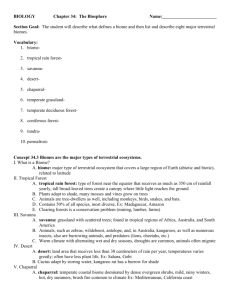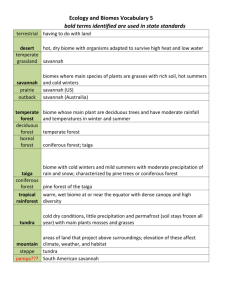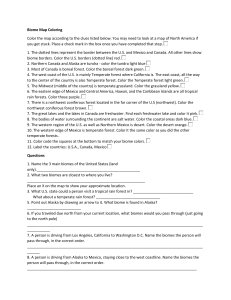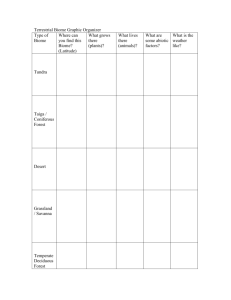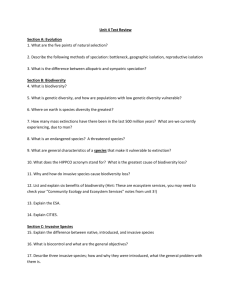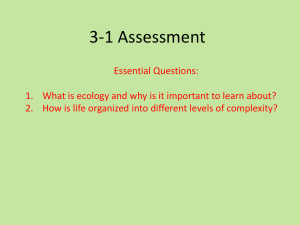Take-Home-Exam - Trupia
advertisement
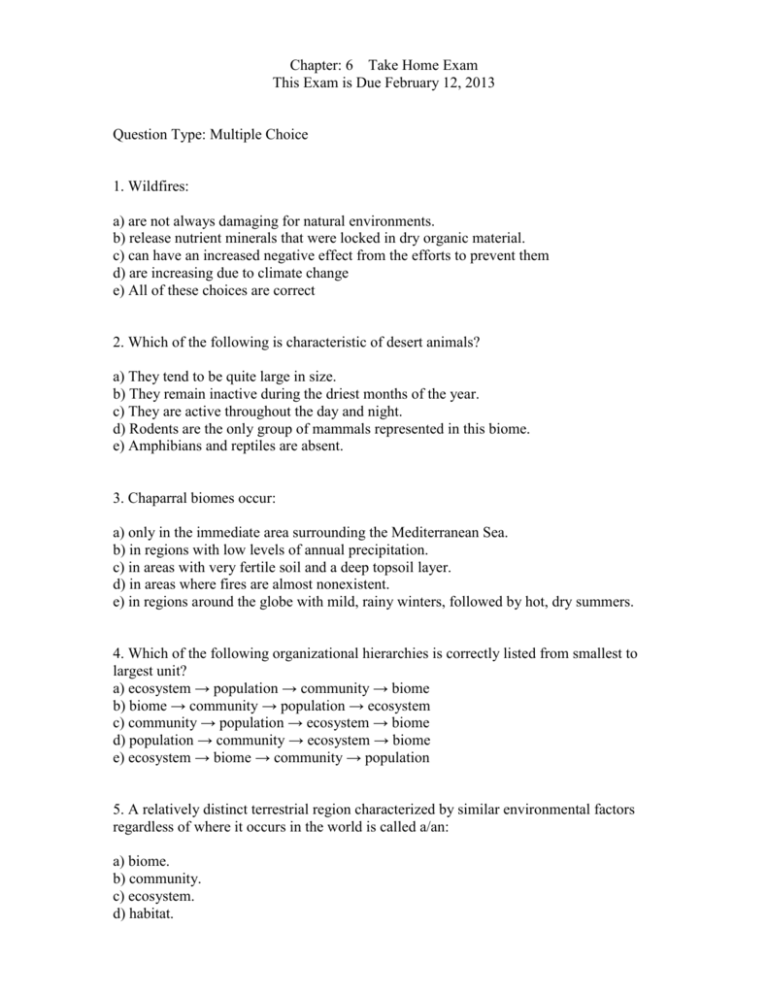
Chapter: 6 Take Home Exam This Exam is Due February 12, 2013 Question Type: Multiple Choice 1. Wildfires: a) are not always damaging for natural environments. b) release nutrient minerals that were locked in dry organic material. c) can have an increased negative effect from the efforts to prevent them d) are increasing due to climate change e) All of these choices are correct 2. Which of the following is characteristic of desert animals? a) They tend to be quite large in size. b) They remain inactive during the driest months of the year. c) They are active throughout the day and night. d) Rodents are the only group of mammals represented in this biome. e) Amphibians and reptiles are absent. 3. Chaparral biomes occur: a) only in the immediate area surrounding the Mediterranean Sea. b) in regions with low levels of annual precipitation. c) in areas with very fertile soil and a deep topsoil layer. d) in areas where fires are almost nonexistent. e) in regions around the globe with mild, rainy winters, followed by hot, dry summers. 4. Which of the following organizational hierarchies is correctly listed from smallest to largest unit? a) ecosystem → population → community → biome b) biome → community → population → ecosystem c) community → population → ecosystem → biome d) population → community → ecosystem → biome e) ecosystem → biome → community → population 5. A relatively distinct terrestrial region characterized by similar environmental factors regardless of where it occurs in the world is called a/an: a) biome. b) community. c) ecosystem. d) habitat. e) population. 6. Tundra a) has an extended day length during its growing season. b) has nutrient-rich soils. c) is characterized by heavy precipitation. d) experiences very long winters and long summers. e) occurs in extreme southern latitudes. 7. The biological community that characterizes the arctic tundra is composed of: a) migrating herbivores, small mammals, and predatory birds. b) large trees. c) mosses, lichens, and dwarf woody plants. d) diverse amphibians and reptiles. e) migrating herbivores, small mammals, predatory birds, mosses, lichens, and dwarf woody plants 8. The biome most suitable for the development of farmland is: a) taiga. b) tropical rain forest c) temperate grassland. d) chaparral. e) tundra. 9. The boreal forest: a) has numerous ponds and lakes formed by grinding ice sheets. b) has warm winters c) has a layer of permafrost. d) cannot support amphibians or reptiles. e) is well suited for conversion to agriculture. 10. The boreal forest is located ______ of the tundra. a) north b) south c) east d) west e) in conjunction 11. The biome with high amounts of precipitation, large narrow-leaved evergreen trees, and epiphytes including lichens is the: a) taiga. b) temperate deciduous forest. c) tropical rain forest. d) boreal forest. e) temperate rain forest. 12. Hot summers and cold winters, topsoil rich in organic material, annual precipitation of 75 to 125 cm (30-50 in), and many hardwood trees are characteristics of the: a) temperate deciduous forest. b) temperate grassland. c) temperate rain forest. d) boreal forest. e) chaparral. 13. Tallgrass prairies do not occur in which of the following states? a) Iowa b) Kansas c) Minnesota d) Florida e) Illinois 14. Shortgrass prairies: a) are moist grasslands with rich soil b) are very similar to desserts c) have drought resistant grasses d) have helpful wildfires e) are moist grasslands with rich soil and have helpful wildfires 15. The Tallgrass Prairie is currently the rarest biome in North America due to: a) rampant urbanization b) recent climate change c) industrial pollution d) conversion to agriculture e) industrial pollution and the conversion to agriculture 16. Which of the following biomes has the highest biodiversity? a) temperate deciduous forest b) savanna c) taiga d) tropical rain forest e) tropical desert 17. Transpiration is the most important source of precipitation for which biome? a) tropical rain forest b) savanna c) tundra d) chaparral e) tropical desert 18. Tropical rain forests: a) are typically composed of at least five distinct layers, or stories, of vegetation. b) are found in areas with high accumulations of organic material in the soil. c) occur in areas with ancient, mineral-poor soil. d) are known for being only moderately productive. e) are known for having moderate levels of biodiversity. 19. Soil in deserts: a) is high in mineral content. b) is high in organic material. c) often contains large amounts of humus. d) supports extensive vegetation. e) All of these choices are correct 20. In temperate lakes, falling temperatures in autumn may cause a mixing of the water layers called: a) thermocline. b) turnover. c) benthos. d) thermal stratification. e) blooms. 21. Free-floating aquatic organisms are known as: a) benthos. b) nekton. c) pelagic inhabitants. d) zooxanthellae. e) plankton. 22. Flowing-water ecosystems, especially headwater streams, receive most of their energy from: a) light. b) water. c) wind. d) organic detritus. e) minerals. 23. The shallow-water area along the shore of a lake or pond is called the __________ zone: a) limnetic b) littoral c) profundal d) headwater e) intertidal 24. Which of the following organisms are representative of the limnetic zone? a) phytoplankton and zooplankton b) frogs and their tadpoles c) cattails and other emergent vegetation d) worms, insect larvae, and crayfish e) All of these choices are correct 25. The deepest zone in a large lake, below where the sunlight penetrates, is the: a) limnetic zone. b) littoral zone. c) profundal zone. d) benthic zone. e) intertidal zone. Answer: c 26. A coastal body of water partly surrounded by land with input from both sea and fresh water is called: a) the limnetic zone. b) an estuary. c) a freshwater wetland. d) the oceanic province. e) a reef. 27. Coral reefs: a) may occur as barrier, fringing, or atoll formations. b) protect coastlines from erosion. c) are found in shallow, nutrient poor, tropical waters. d) are the most diverse of all marine environments. e) All of these choices are correct 28. The thermocline is the layer in a lake at which a) pollutants are trapped and held b) the warm upper zone meets the cold lower zone c) nutrient levels are the lowest d) light no longer penetrates enough for photosynthesis to occur e) the oxygen level is the lowest 29. Deciduous forests a) have very little precipitation b) have very week topsoil c) have trees that shed their leaves seasonally d) are not useful commercially e) are not found in the US 30. What are the two problems that override all other problems in the Everglades today? a) The Everglades receives too little water, and the water it receives is polluted with nutrient minerals from agricultural runoff b) The Everglades has too many foreign species crowding out natives, and as a National Park cannot expand in size. c) The Everglades receives too much water, and the water it receives comes in destructive floods due to breeches in the levee system. d) Urban growth and expansion of agriculture into the southernmost areas are responsible for loss of biodiversity in the area. e) The Everglades depends on the Florida aquifer for clean, fresh water, however that water is being diverted to golf courses and the aquifer is running dry. 31. Which of the following does not apply to the tundra biome? a) few species are found b) harsh winters and short summers c) the biome is dominated by mosses, lichens, sedges and grasses d) no permafrost e) tundra plants seldom grow taller than 30 cm (12 in) 32. All of the following apply to the tundra biome except: a) abundant average precipitation of 75 to 125 cm (30 to 50 in) per year b) permafrost c) nutrient-poor soils d) little organic matter e) long, harsh winters and short cool summers 33. The biomes that commonly have fire-adapted species are: a) temperate grassland, savanna, and boreal forest. b) desert, temperate grassland, and savanna. c) temperate grassland, savanna, and tundra. d) chaparral, temperate grassland, and savanna. e) temperate grassland, chaparral, and temperate deciduous forest. 34. Which of the following is not a biome? a) boreal forest b) desert c) mangrove forest d) savanna e) tundra 35. Which of the following biomes is not known for its wood and lumber production? a) temperate rain forest b) taiga c) chaparral d) temperate deciduous forest e) tropical rain forest 36. All of the following are fire-adapted except: a) African savannas b) jack and ponderosa pines c) most hardwood trees d) bur oak e) California chaparrals 37. The dominant vegetation of the temperate rain forest includes all of the following except: a) western hemlock. b) Douglas fir. c) western red cedar. d) hickory. e) Sitka spruce. 38. Which of the following abiotic factors does not typically affect biome structure? a) elevation b) wildfires c) droughts d) salinity e) floods 39. The biomes known for supporting herds of grazing animals are: a) temperate grassland and temperate deciduous forest. b) temperate grassland and savanna. c) temperate deciduous forest and boreal forest. d) boreal forest and temperate grassland. e) savanna and tropical rain forest. 40. Which of the following does not apply to a biome? a) level of ecological organization above ecosystem b) boundaries are determined by climate barriers c) near poles temperature overrides climate d) usually confined to a relatively small geographical area e) in tropical and temperate regions precipitation is more significant then temperature 41. Which of the following statements about desert inhabitants is not true? a) Both annual and perennial plants live in the desert. b) Desert animals typically have adaptations for conserving water, but plants require no special adaptations. c) Many desert plants are protected from predation by thorns and toxins. d) Desert animals are typically small and nocturnal. e) All of these choices are true 42. Which of the following is not a major component of desert animal life? a) insects b) reptiles c) amphibians d) owls e) rodents 43. Which of the following characterizes both the savanna and the chaparral? a) periodic fires b) extensive stands of trees c) large herds of herbivorous mammals d) soils with high mineral content e) moist summers and dry winters 44. Which of the following is not important in determining the distribution of organisms in aquatic biomes? a) light penetration b) mineral nutrient concentrations c) water d) salinity e) waves and currents 45. Which of the following does not apply to headwater flowing streams? a) small streams b) usually highly oxygenated c) shallow and swift flowing d) cold e) cloudy due to suspended particles 46. Which of the following does not apply to the profundal zone of a large lake? a) no light penetration b) it is the deepest zone c) effective recycling of minerals d) lacks oxygen (anaerobic) e) a mineral-rich zone 47. Which of the following does not apply to freshwater wetlands? a) anaerobic conditions b) accumulate organic material c) water-tolerant vegetation d) increase potential for flooding e) help to purify groundwater 48. Which of the following is not found at the boundary between terrestrial and aquatic ecosystems? a) estuary b) oceanic province c) mangrove forest d) salt marsh e) intertidal zone 49. Ecosystem services supported by the estuarine environment include all of the following except: a) biological habitat. b) trapping pollution. c) groundwater supply. d) storm buffering. e) marinas. 50. What do inhabitants of the rocky intertidal zone not do to protect themselves? a) follow tides in and out b) use an anchor or some other means of attachment. c) seal in moisture with a closing shell or other adaptations d) hide under rocks e) none of these choices is correct 51. Which of the following would not be found exclusively in the benthic environment? a) seagrass beds b) coral reefs c) oysters, clams, and barnacles d) kelp forests e) nekton 52. Which of the following pairs is incorrect? a) coral reefs – zooxanthellae b) seagrasses – estuaries (mangroves) c) kelps – large brown algae d) benthic environment – mud or sand e) euphotic zone – photosynthesis 53. Which of the following is not a source of human impact on the marine environment? a) coastal development, both residential and industrial b) global warming c) trash d) increased levels of O2 e) chemical pollution from pesticides, heavy metals, and synthetic chemicals 56. Which biome is mismatched with the statement that follows it? a) Tropical rain forest - plants grow in layers: canopy, understory b) Tundra: most fragile biome on this planet c) Boreal forest: well suited for agriculture because of short growing season and mineralpoor soil d) Tropical grassland: trees and grasses have fire-adapted features such as extensive underground root systems. e) Desert: plant cover is sparse and soil is low in organic material but high in mineral content 57. Humid tropical rain forests have extraordinary biological diversity a) because of the abundance of nutrient minerals in tropical soils b) due to human intervention in planting rare and endangered species c) because of the many pollinators that also call the tropical rain forest home d) due to local factors, such as varying soil fertility and topography e) because the plants capture a lot of energy by photosynthesis 58. Which of the following human impacts is mismatched with the detrimental effect it has had on a biome? a) Oil and natural gas exploration: long-lasting injury due to slow regeneration of the tundra b) Mining, drilling for gas and oil, and farming: loss of boreal forest (deforestation) c) Overharvesting of old-growth forest: loss of temperate rain forest habitat for endangered and threatened species d) Off-road vehicle damage and military exercises: erosion and loss of vegetation in the desert e) Hunting and fishing: desertification of the savanna, tropical grasslands 59. Wetlands are important for all of the following reasons EXCEPT: a) They support high species diversity. b) They reduce flooding by slowing the velocity of runoff water. c) They help recharge groundwater aquifers. d) They contribute to asymmetry in urban communities. e) They sometimes detoxify substances in the water. 60. National Marine Sanctuaries include a) kelp forests off the coast of California b) coral reefs in the Florida Keys c) fishing grounds along the continental shelf d) deep submarine canyons e) all of these choices are correct 61. The benthic environment includes all of the following except a) the bathyal zone b) the ocean floor from the intertidal zone to the deep ocean trenches c) the abyssal zone d) the bendal e) the hadal zone 62. Humans harm the oceans in all of the following ways EXCEPT a) Developing along the coast b) Polluting the land c) Recycling d) Killing marine life with trash e) With chemicals from the agriculture and industry 63. Which of the following can be found in kelp forests? a) crabs b) tube worms c) sea cucumbers d) sea otters e) all of these choices are correct 64. The most fundamental division in aquatic ecology is a) salinity b) sunlight c) estuaries d) biomes e) differences in sea life 65. Increases in temperature lead to coral bleaching because: a) warmer temperatures cause the coral exoskeleton to break down b) the stressed coral polyps lose their zooxanthellae c) the stressed coral polyps are unable to acquire enough food d) the warmer water is too turbid to allow light to penetrate down to the depth of the reef e) the stressed coral polyps lose their zooxanthellae and the stressed coral polyps are unable to acquire enough food



